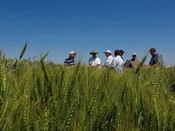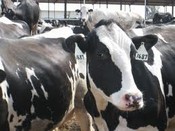 |
IndustryWheat grown in the southwestern United States (California and Arizona) has characteristics that differentiate it from wheat produced elsewhere in the United States. California wheat is low in moisture and high in kernel weight and kernel size. These characteristics are positive attributes in the milling industry.

|
A large proportion of California's common wheat is used for milling into bread flour or general purpose flour. Varying amounts are sold for feed, depending on price, supply, demand, and grain quality. California wheat is sold both in domestic and foreign markets.
Durum wheat is grown specifically for semolina, a high protein content flour that is used to make macaroni, spaghetti, and other noodle products. Desert Durum® wheat is exported "identity preserved" i.e., not mixed with other durum wheat that does not have the Desert Durum® trademark and quality traits associated with that designation.
Domestic Market
With a total of 128,182 cwts (hundredweights) of daily flour and durum milling capacity per day in 2017, California boasts the largest milling capacity in the United States. Because California does not produce the quantities and diversity of quality characteristics needed, wheat is also railed in from other states.
The Commission laboratory staff is available to work for customers in the area of quality assurance, problem solving, quality control training, and research. The staff has the expertise to answer technical questions about California's wheat quality, and can offer recommendations for tempering, blending and appropriate end-use applications. A description of Wheat Quality factors and Durum Semolina Quality factors and the Laboratory Price Lists can be found on the Milling/Baking Lab page.

|
Feed
California consistently ranks in the top five U.S. states for livestock products and has been the leading dairy state since 1993.* A fair percentage of California's wheat grain production is used to feed these animals, depending on the price of competing grains. And because of the sizeable dairy industry, a large percentage of California's wheat crop never makes its way into the grain channels. From 2012-2016, an average of 60% of the common wheat planted in California was used for silage, green chop, forage, or hay. California still must import millions of tons of feed stuff into the state to meet the needs of the livestock industry.

|
Export Market
The California Wheat Commission is a member of US Wheat Associates (USW), which acts as the international market development entity for the entire U.S. wheat industry. USW has offices strategically located around the world to help wheat buyers, millers, bakers, wheat food processors, and government officials understand the quality, value, and reliability of U.S. wheat. Membership in USW provides California wheat growers with market intelligence, customer access and the opportunity to participate in outgoing trade teams and incoming trade missions.

|
California has several port locations in the state. The Port of Stockton and Port of West Sacramento can handle bulk shipments of wheat out of the state whereas other ports, such as the Port of Oakland and the Port of L.A./Long Beach only transport containers. Depending on truck/rail rates and the location of foreign demand, California also has options for exporting out of the Gulf of Mexico and Pacific Northwest ports.

|
A large proportion of the Desert Durum® grown in southern California is exported. From MY12/13 to MY16/17 (last 5 years), an average of 177,686 metric tons/year of California and Arizona Desert Durum® were exported, mainly to Italy and Nigeria. Most of this Desert Durum® wheat is exported identity preserved through U.S. Gulf ports.
Increasingly, more Hard White and other classes of California wheat are being exported by a container.
* Source: USDA. Livestock and livestock products include milk, beef cattle, eggs, sheep, turkeys, hogs, and horses.

|
|
 |



